lexander Iolas was born in Alexandria, Egypt, as Constantinos Coutsoudis. He was the firstborn son of Andreas and Persephone Koutsoudi. Three more siblings followed, Dimitrios, Niki and Iro. They grew up in Alexandria and were the offspring
of a wealthy cotton merchant family.
Alexander Iolas, however, showed an inclination towards the arts from early on, so in
1928 he decided to spread his wings and move to Athens, on Konstantinos Kavafis's
suggestion, with whom he had come in contact thanks to the Physical Education
professor at his school, Michail Hadjidimitriou – whose literary nickname was Glafkos
Alithersis – and to Nikos K. Nikolaidis, one of the most important writers of the
Interwar Period.
In Greece, Alexander Iolas began to associate with an important circle of artistic
people, such as Kostis Palamas and his daughter Nausicaa, Angelos Sikelianos,
who even played a role as a teacher in Iolas's life, but also Eva Palmer-Sikelianos.
The wish he inherited from Sikelianos and which he followed faithfully until 1976 was
“Grow Eternal”.
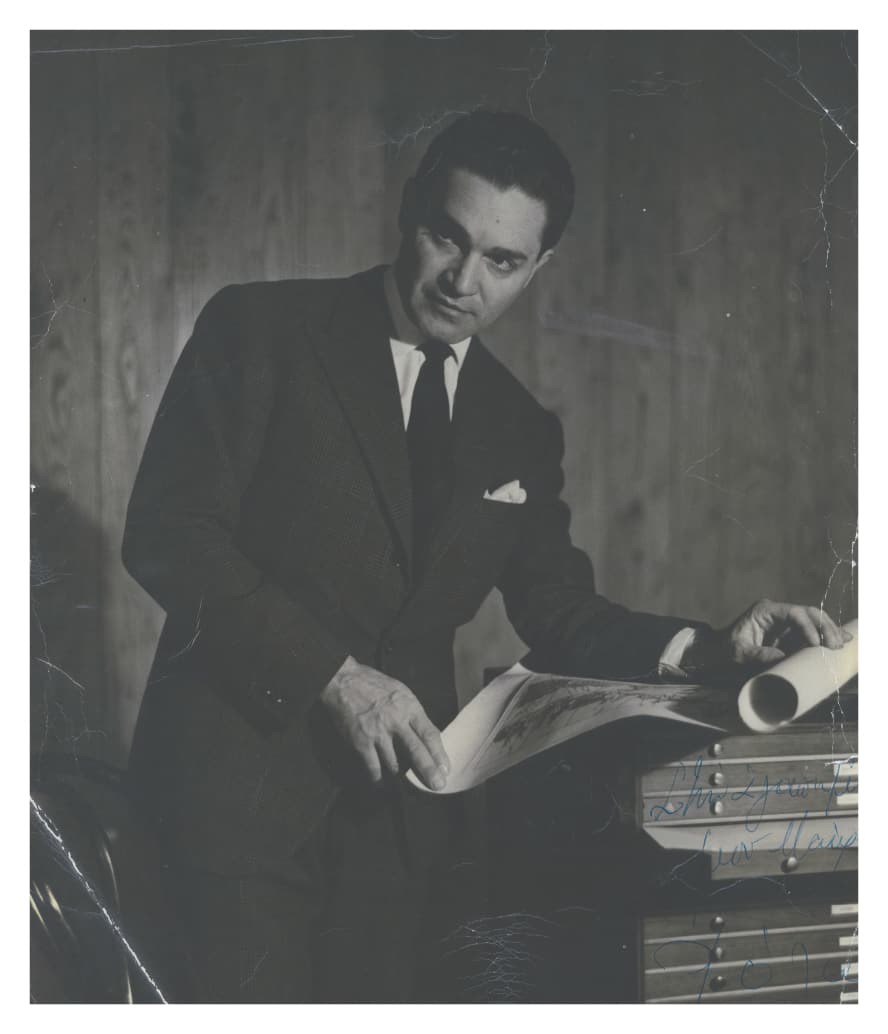
Alexander Iolas int the 60s Portrait © Lena Koutsoudi - Iolas Archive

It was in Athens that he took his first dancing steps. In 1930 he left for Berlin, at the instigation of Dimitris Mitropoulos, where he devoted himself to Dance Studies. He studied at the school run by the Gsovsky couple, Tatjana and Victor and participated in the Salzburg Festival in 1931 and 1932. The rearrangement of his name was of his own invention. He was already appearing in theatre programmes as Jolas Coutsoudis since 1931, long before he went to America and met Theodora Roosevelt.
In November of 1932, Iolas moved to Paris where he continued to study ballet, still with very important teachers, while at the same time attending some Art classes at the Sorbonne University. In Paris he met Florence Meyer, an influential name of American society. Her father, Eugene Meyer, was the one who helped him get the Green Card in 1936.
It was the first step for him to be able to work legally in America.
In 1935, Alexander Iolas went to New York as a visitor. And it was there, on the 14 th
of December 1935, that he signed a contract with the Ballet Productions dance
troupe and made his debut at the Metropolitan Opera House, dancing in La Traviata.
On the 19 th of November 1945, Alexander Iolas was sworn as American citizen,
signing as Constantine Coutsoudis -the official change of his name took place later.
Gradually, “Iolas” replaced his last name, as it was more euphonic, and it only had
two syllables, and was, therefore, easier to pronounce. But it was mostly symbolic,
since it is associated with Iolaus, an important personality of Greek mythology.
Similarly, Alexander was a glorious name, closely related to his homeland.
It was in 1945 that Iolas decided to give up dancing and seeked a way to transition
into Art. It was rumoured that this transition was due to an injury he had sustained,
but Iolas was already 37 years old at the time, and, as he had also pointed out
himself, too old to continue dancing.
His first contact with painting began in Paris, when he was still a dancer. In 1937 he
fell in love with a painting by Giorgio de Chirico which he first saw at the Galerie des
Quatre Chemins in Paris. De Chirico was a representative of the Scuola Metafisica,
while he also influenced Surrealism and Dadaïsm.
It was on the 1 st of September 1945 in New York, that the first gallery was officially
founded, bearing the name Hugo Gallery; in honour of François Hugo, last husband
of Donna Maria Ruspoli, a close friend of Iolas. She was the one who helped him
through the times of hardship. She got him in touch with the de Menil couple, who
entrusted him to curate their collection, which they housed at The Menil Collection
Museum in Houston, Texas. Iolas began exhibiting the works of European surrealist
artists, such as René Magritte, Max Ernst, Giorgio de Chirico and Victor Brauner,
among others. In 1952 he also held Andy Warhol's first exhibition at the New York
gallery.

Later, he collaborated with the Nouveaux Realistes (Niki de Saint Phalle, Jean
Tinguely, Martial Raysse etc.), with artists of the Arte Povera (Yannis Kounellis, Pino
Pascali etc.), and many others. In 1954, the gallery expanded and was renamed
Alexander Iolas Inc.
Alexander Iolas was one of the pioneers in the development of a “network” of art
galleries across Europe, all satellites of a single central gallery. It started in Geneva
(1963) and then followed galleries in Paris (1964), Milan (1966) – first located at 3
Via Rossini and later relocated to 12 Via Manzoni – Zurich, Madrid and Rome. The
last three were in common partnership. At the same time, he promoted many Greek
artists abroad, such as Hadjikyriakos-Ghikas, Vagis, Moralis and Tsarouchis. He
also collaborated with the younger generation of Greek artists such as Tsoklis,
Pavlos, Takis, Akrithakis, Fassianos, Mara Karetsou, Yannis Bouteas, Marina
Karella and Kostas Paniaras.
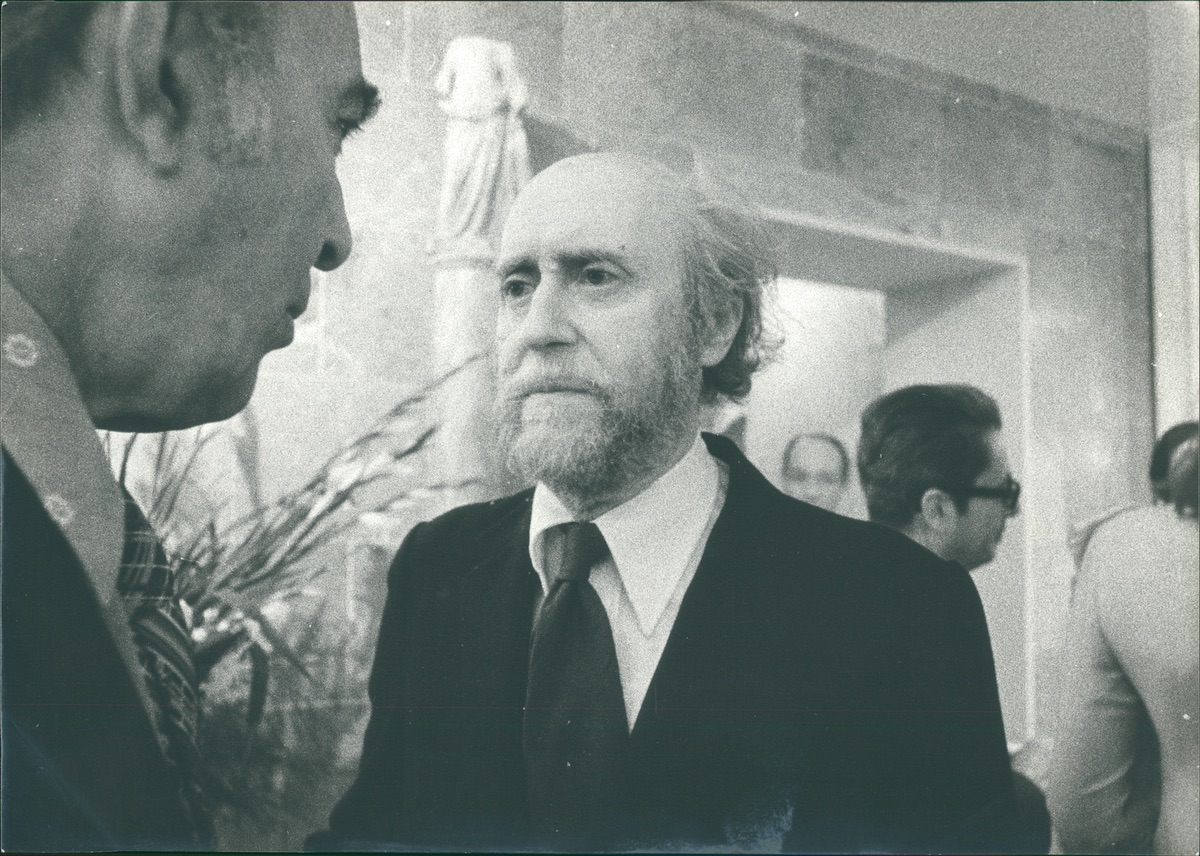
Tsarouchis during a reception in the house of Aghia Praskevi © Eleni - Koutsoudi - Iolas archive
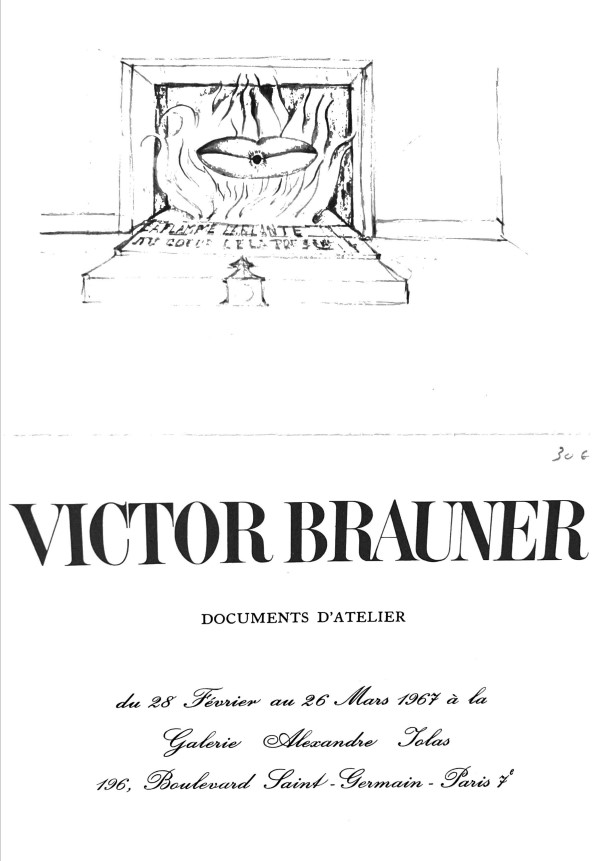
The golden age of his career began in 1965 and ended in 1976. He published art
catalogues, introducing, among others, André Breton and Pierre Restany, as well as
limited edition collectable books by artists and poets (Max Ernst, Yannis Ritsos,
Odysseas Elytis, etc.). He donated works to major museums such as the MOMA in
New York, the Centre Georges-Pompidou in Paris (1977), the National Gallery in
Athens (1971) and the Macedonian Museum of Contemporary Art in Thessaloniki
(1984).
Having gained worldwide fame, he often said he would return in Greece, to
contribute to the progress of it’s artistic life. The fall of the Greek Junta had paved
the way. Gradually he closed down all of his galleries except for one in New York,
thus keeping the promise he had made to Max Ernst, to close his galleries after his
friend’s death. This decision of his must have been influenced by the fact that many
artists of the “old guard” passed away in the 1970s, people by whom Iolas had been
nurtured and for whom he had deep love and respect. In Greece he collaborated
with various galleries such as Zoumboulakis-Iolas, Medusa, Vicky Drakou, Athens
Art Gallery, Skoufa.

From 1985 until his death in 1987, Iolas was treated in a spiteful manner by a large section of the Greek press, who had created a vulgar image in his stead. He was even accused of antiquities trafficking, a case that never made it to court due to his death, while all other accusations melted away, since they were unfounded. While he was still alive, there was an effort from abroad to defend Iolas, at the initiative of Kostas Gavras, which was co-signed by many internationally recognised personalities, among them Tsarouchis and Hadjidakis as well as the byzantinologist and historian Eleni Glykatzi-Arveler. In 1984, he donated 47 works of contemporary art from his personal collection to the Macedonian Museum of Contemporary Art. In 1987, Alexander Iolas died in a New York hospital, defeated by AIDS.
The house took form gradually, through successive extensions over a period of forty years. From 1951 to 1959, there were three successive extensions. The original building permit by engineer Athanasios Staikos was followed in 1956 by a permit by civil engineer Dimitris Kremmydas and in 1959, by a permit by civil engineer Emmanuel Karantinos.
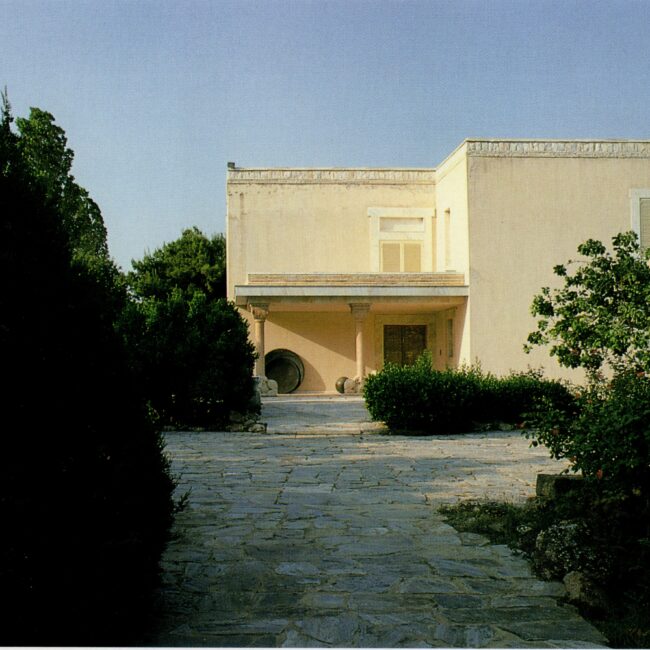
The spectacular transformation of the house began in 1971 with the addition of the second floor that was gradually completed by 1975, while the decoration got a complete makeover. The latest addition to the house was with a permit by civil engineer Pavlos Mavrias. The original idea was to use the Italian office Quadrio Curzio's designs (1972). This plan never materialized. Iolas modified it when he decided to order an impressive balustrade from the Lalannes. The upper floor began taking the form of an “exhibition space” with works by Takis, Tsoklis and Lalanne. The ground floor remained a habitable house, with living rooms, a few bedrooms and auxiliary spaces, while the wardrobe was moved to the basement. Various myths circulate and are being reproduced until today about the names of the architects of the house, such as Tsarouchis or Pikionis, while, what was bronze was being transmuted to gold, like all the doors of the house, including the front door. The myth that the house was initially built as a museum has no factual basis. It's currently in the hands of the Municipality of Agia Paraskevi.
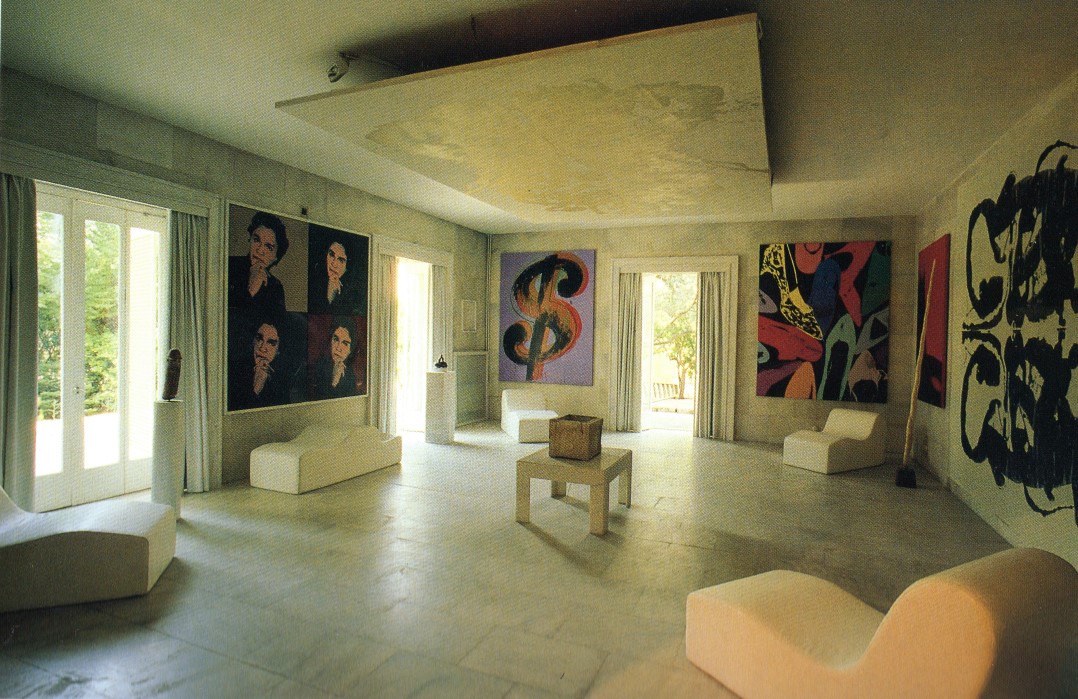

Iolas House after his Death - Lalanne Staircase © Greek Style 1988 Gilles de Chabaneix

Iolas House after his Death - Library © Greek Style 1988 Gilles de Chabaneix
The Alexander Iolas Collection consisted of about 1,200 works of art and antiquities. Iolas was a recognized antiquities collector since 1966, following a decision of the Central Archaeological Council, as recommended by the Archaeological and Private Collections Service. At the time of his death, the A.I Collection of Antiquities consisted of 854 artifacts. It undoubtedly was a remarkable collection, that included many important pieces. Greek and Roman antiquities were standing adjacent to Byzantine icons. Additionally, there were 195 works of modern art, 30 pieces of furniture, and 82 decorative pieces, which included works by – among others – Andy Warhol, Pablo Picasso, Max Ernst, Niki de Saint Phalle, Lalanne, Roberto Matta, René Magritte and Victor Brauner. Of course, Greek artists’ works were not lacking in his collection, such as Takis (Panagiotis Vassilakis), Kostas Tsoklis, Marina Karella, Kostas Paniaras, and others. After his death, there were seven or eight burglaries at the house of Agia Paraskevi. The most significant one was in March of 1989, when 628 antiquities were stolen. Following this incident, the 149 remaining antiquities were transferred to various museums in Greece for safekeeping. In the years that followed, apart from the antiquities, 50 works of modern art were also stolen, while some Egyptian objects and many catalogues were incinerated during an arson. To date, none of the stolen items have been located.
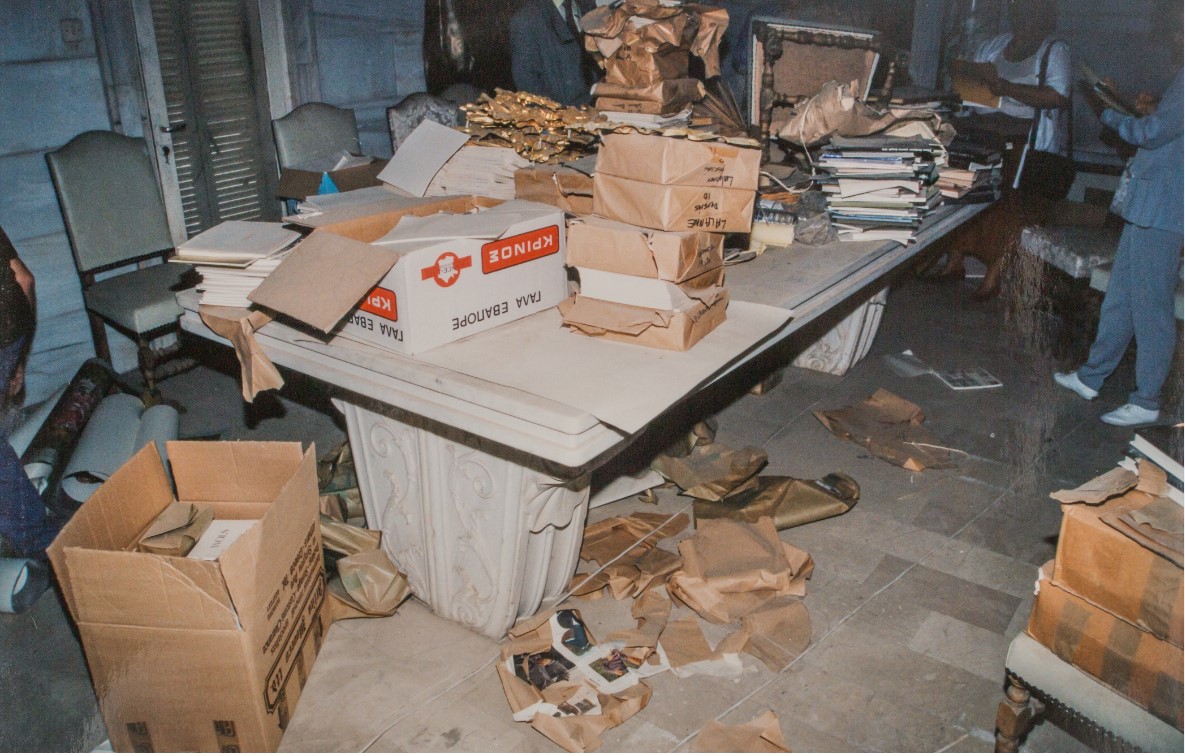
The looted house in 2001 © Eleni - Koutsoudi - Iola archive

The looted house in 2001 © Eleni - Koutsoudi - Iola archive
Αλέξανδρος Ιόλας γεννήθηκε στην Αλεξάνδρεια της Αιγύπτου ως Κωνσταντίνος Κουτσούδης. Ήταν ο πρωτότοκος γιος του Ανδρέα και της Περσεφόνης Κουτσούδη. Στην συνέχεια ακολούθησαν άλλα τρία αδέρφια, ο Δημήτριος, η Νίκη και η Ηρώ. Μεγάλωσαν στην Αλεξάνδρεια και ήταν γόνοι μιας ευκατάστατης οικογένειας βαμβακέμπορων. Ο Αλέξανδρος Ιόλας ωστόσο έδειξε από νωρίς την κλίση του στις τέχνες κι έτσι το 1928 αποφάσισε να ανοίξει τα φτερά του μετακομίζοντας στην Αθήνα καθ’ υπόδειξη του Κωσταντίνου Καβάφη, με τον οποίο είχε έρθει σε επαφή χάρη στον καθηγητή Φυσικής Αγωγής του σχολείου του Γλαύκο Αλιθέρση -του οποίου το φιλολογικό ψευδώνυμο ήταν Μιχαήλ Χατζηδημητρίου- και του Νίκου Κ. Νικολαΐδη, ενός εκ των σημαντικότερων συγγραφέων του Μεσοπολέμου. Στην Ελλάδα, ο Αλέξανδρος Ιόλας ξεκίνησε να συναναστρέφεται με έναν σημαντικό καλλιτεχνικό κύκλο ανθρώπων, όπως ο Κωστής Παλαμάς και η κόρη του Ναυσικά, ο Άγγελος Σικελιανός, ο οποίος μάλιστα διαδραμάτισε ρόλο δασκάλου στη ζωή του Ιόλα, αλλά και την Εύα Πάλμερ-Σικελιανού. Η ευχή που κληρονόμησε από τον Σικελιανό και την ακολούθησε πιστά μέχρι το 1976 ήταν το «Αύξου αεί».

Ο Αλέξανδρος Ιόλας την δεκαετία του 60s © Lena Koutsoudi - Iolas Archive

Στην Αθήνα έκανε και τα πρώτα του βήματα στον χορό. Το 1930, με προτροπή του Δημήτρη Μητρόπουλου, έφυγε για το Βερολίνο, όπου αφιερώθηκε στις σπουδές χορού. Σπούδασε στη σχολή που διατηρούσε το ζεύγος Tatjana και Victor Gsovsky, ενώ έλαβε μέρος στο Salzburg Festival από το 1931 έως το 1932.Η αναδιάρθρωση του ονόματός του ήταν δικής του επινόησης. Ως Jolas Coutsoudis είχε ήδη εμφανιστεί στα θεατρικά προγράμματα από το 1931, δηλαδή πολύ πριν πάει στην Αμερική και γνωρίσει την Theodora Roosevelt.Τον Νοέμβριο του 1932, ο Ιόλας μετακόμισε στο Παρίσι όπου συνέχισε να μελετά μπαλέτο με πολύ σημαντικούς δασκάλους, ενώ παράλληλα παρακολούθησε και κάποια μαθήματα Τέχνης στη Σορβόννη. Την περίοδο που βρισκόταν στο Παρίσι γνώρισε την Florence Meyer, ισχυρό όνομα της αμερικανικής κοινωνίας. Ο πατέρας της, Eugene Meyer, ήταν εκείνος που τον βοήθησε να αποκτήσει την Πράσινη Κάρτα το 1936. Ήταν ένα βήμα για να μπορέσει να εργαστεί νόμιμα στην Αμερική.
Το 1935, ο Αλέξανδρος Ιόλας πήγε ως επισκέπτης στη Νέα Υόρκη. Εκεί, στις 14/12/1935, υπέγραψε συμβόλαιο με τον χορευτικό θίασο Ballet Productions και έκανε το ντεμπούτο του στο Metropolitan Opera House χορεύοντας στην Traviata. Στις 19/11/1945 ο Αλέξανδρος Ιόλας ορκίστηκε Αμερικανός πολίτης υπογράφοντας ως Constantine Coutsoudis, αφού η επίσημη αλλαγή του ονόματός του έγινε αργότερα. Σταδιακά το Ιolas έλαβε τη θέση του επιθέτου, καθώς ήταν πιο εύηχο, δισύλλαβο και άρα πιο εύκολο στην προφορά. Κυρίως όμως ήταν συμβολικό, αφού συνδεόταν με τον Ιόλαο, σημαντικό πρόσωπο της ελληνικής μυθολογίας. Αντίστοιχα, το Αλέξανδρος ήταν ένα ένδοξο όνομα, στενά συνδεδεμένο με τη χώρα στην οποία είχε γεννηθεί.Το 1945 είναι η χρονιά που ο Ιόλας αποφασίζει να εγκαταλείψει τον χορό και να αναζητήσει έναν τρόπο μετάβασης προς την Τέχνη. Φημολογήθηκε ότι η μετάβαση αυτή έγινε λόγω ενός τραυματισμού που είχε, όμως το 1945 ο Ιόλας ήταν ήδη 37 ετών και όπως είχε πει κι ο ίδιος ήταν πλέον πολύ μεγάλος για να συνεχίσει να χορεύει.Η πρώτη του επαφή με την ζωγραφική ξεκίνησε στο Παρίσι όσο ήταν ακόμα χορευτής. Το 1937 ερωτεύτηκε έναν πίνακα του Giorgio de Chirico τον οποίο είδε για πρώτη φορά στην Galerie des Quatre Chemins στο Παρίσι. O de Chirico ήταν εκπρόσωπος της Scuola Metafisica, ενώ επηρέασε τον Σουρεαλισμό και το κίνημα του Dada. Tην 1 Σεπτεμβρίου 1945 ιδρύθηκε επίσημα στη Νέα Υόρκη η πρώτη γκαλερί, η οποία έφερε την ονομασία «Hugo Gallery», προς τιμήν του François Hugo, τελευταίου συζύγου της Donna Maria Ruspoli, στενής φίλης του Ιόλα. Εκείνη ήταν που τον βοήθησε τα δύσκολα χρόνια. Τον έφερε σε επαφή με το ζεύγος de Menil, οι οποίοι τον εμπιστεύτηκαν να τους φτιάξει την συλλογή τους, την οποία στέγασαν στο μουσείο The Menil Collection στο Χιούστον του Τέξας. Ο Ιόλας ξεκίνησε εκθέτοντας έργα από Ευρωπαίους σουρεαλιστές καλλιτέχνες, όπως τον René Magritte, τον Max Ernst, τον Giorgio de Chirico, τον Victor Brauner κ.α. Στην γκαλερί της Νέας Υόρκης πραγματοποίησε το 1952 και την πρώτη έκθεση του Andy Warhol.

Αργότερα, συνεργάστηκε με τους Nouveaux Realistes (Niki de Saint Phalle, Jean Tinguely, Martial Raysse κ.α.), με καλλιτέχνες της Arte Povera (Γιάννης Κουνέλλης, Pino Pascali κ.α.) και πολλούς άλλους. Το 1954 η γκαλερί επεκτάθηκε και μετονομάστηκε σε Alexander Iolas Inc.Ο Αλέξανδρος Ιόλας αποτέλεσε έναν από τους πρωτοπόρους στην ανάπτυξη ενός «δικτύου» από αίθουσες τέχνης ανά την Ευρώπη, δορυφόρους μιας κεντρικής γκαλερί. Ξεκίνησε από την Γενεύη (1963) και ακολούθησαν οι γκαλερί στο Παρίσι (1964), στο Μιλάνο (1966) -η πρώτη στην 3 Via Rossini που αργότερα μεταφέρθηκε στην 12 Via Manzoni- στη Ζυρίχη, στη Μαδρίτη και στη Ρώμη. Οι τελευταίες τρεις με την μορφή συνεργασίας. Παράλληλα, προώθησε στο εξωτερικό Έλληνες καλλιτέχνες, όπως τον Χατζηκυριάκο-Γκίκα, τον Βαγή, τον Μόραλη και τον Τσαρούχη. Συνεργάστηκε επίσης με τη νεότερη γενιά Ελλήνων όπως ήταν ο Τσόκλης, ο Παύλος, ο Takis, ο Ακριθάκης, ο Φασιανός, η Μάρα Καρέτσου, ο Γιάννης Μπουτέας, η Μαρίνα Καρέλλα, ο Κώστας Πανιάρας κ.α.

Ο Γιάννης Τσαρουχης σε δεξίωση στο σπίτι της Αγίας Παρασκευής © Eleni - Koutsoudi - Iolas archive

Η χρυσή εποχή της καριέρας του ξεκίνησε το 1965 και τελείωσε το 1976. Εξέδωσε καταλόγους τέχνης, τους οποίους προλόγισαν, μεταξύ άλλων, ο André Breton και ο Pierre Restany, καθώς και συλλεκτικά βιβλία καλλιτεχνών και ποιητών σε περιορισμένο αριθμό αντιτύπων (Max Ernst, Γιάννης Ρίτσος, Οδυσσέας Ελύτης κ.α.). Δώρισε έργα σε μεγάλα μουσεία, όπως το MOMA της Νέας Υόρκης, το Centre Georges-Pompidou στο Παρίσι ( 1977), στη Εθνική Πινακοθήκη της Αθήνας (1971) και στο Μακεδονικό Μουσείο Σύγχρονης Τέχνης στην Θεσσαλονίκη (1984). Έχοντας πλέον αποκτήσει παγκόσμια φήμη, έλεγε συχνά ότι θα γύριζε στην Ελλάδα για να συμβάλει στην πρόοδο της καλλιτεχνικής της ζωής. Άλλωστε, η πτώση της Χούντας είχε ανοίξει τον δρόμο. Σταδιακά έκλεισε όλες τις γκαλερί του εκτός από μία στη Νέα Υόρκη, κρατώντας έτσι την υπόσχεση που είχε δώσει στον Max Ernst, να σταματήσει όταν εκείνος θα πέθαινε. Στην απόφασή του αυτή, πρέπει να έπαιξε σημαντικό ρόλο και το γεγονός ότι την δεκαετία του ’70 έφυγαν από τη ζωή πολλοί καλλιτέχνες της παλαιάς φρουράς, άνθρωποι με τους οποίους ο Ιόλας είχε γαλουχηθεί και για τους οποίους έτρεφε βαθιά αγάπη και σεβασμό. Στην Ελλάδα, συνεργάστηκε με διάφορες γκαλερί όπως οι Ζουμπουλάκη-Ιόλα, Μέδουσα, Βίκυ Δράκου, Αίθουσα Τέχνης Αθηνών, Σκουφά.

Από το 1985 μέχρι και τον θάνατό του το 1987, ο Ιόλας αντιμετωπίστηκε με κακεντρέχεια από μεγάλη μερίδα του ελληνικού Τύπου, ο οποίος δημιούργησε για εκείνον μία χυδαία εικόνα. Κατηγορήθηκε μέχρι και για αρχαιοκαπηλία, μία υπόθεση που δεν πρόλαβε ποτέ να φτάσει στο δικαστήριο διότι πέθανε, ενώ οι όποιες άλλες κατηγορίες εξανεμίστηκαν, αφού ήταν αβάσιμες. Όταν ήταν ακόμα εν ζωή, με πρωτοβουλία του Κώστα Γαβρά, υπήρξε από το εξωτερικό μία προσπάθεια υπεράσπισης του Ιόλα, την οποία συνυπέγραψαν πολλές διεθνείς προσωπικότητες, ανάμεσά τους και η βυζαντινολόγος-ιστορικός Ελένη Γλύκατζη-Αρβελέρ, ο Τσαρούχης και ο Χατζιδάκις. Το 1984, πραγματοποίησε τη δωρεά 47 έργων σύγχρονης τέχνης από την προσωπική του συλλογή στο Μακεδονικό Μουσείο Σύγχρονης Τέχνης. Το 1987, ο Αλέξανδρος Ιόλας απεβίωσε, σε νοσοκομείο της Νέας Υόρκης, νικημένος από τη νόσο του AIDS .
Η κατοικία διαμορφώθηκε σταδιακά, μέσα από αλλεπάλληλες επεκτάσεις σε διάστημα σαράντα ετών. Από το 1951 έως το 1959 έγιναν τρεις διαδοχικές επεκτάσεις. Η πρώτη από τον μηχανικό Αθανάσιο Στάικο. Το 1956 ακολούθησε, σε μελέτη του πολιτικού μηχανικού Δημήτρη Κρεμμύδα και το 1959, σε μελέτη του πολιτικού μηχανικού Εμμανουήλ Καραντινού.

Η θεαματική μετατροπή του σπιτιού ξεκίνησε το 1971 με την προσθήκη του δευτέρου ορόφου που ολοκληρώθηκε σταδιακά μέχρι το 1975, ενώ άλλαξε τελείως η διακόσμηση. Η τελευταία προσθήκη έγινε σε μελέτη του πολιτικού μηχανικού Παύλου Μαυρία. Η αρχική σκέψη ήταν να γίνει με σχέδια του Ιταλικού γραφείου Quadrio Curzio(1972). Τελικά, αυτό το σχέδιο δεν ακολουθήθηκε ποτέ. Ο Ιόλας το τροποποίησε όταν αποφάσισε να παραγγείλει μια εντυπωσιακή κουπαστή από το ζεύγος Lalanne. Ο επάνω όροφος είχε αρχίσει να παίρνει μορφή «εκθεσιακού χώρου» με έργα Takis, Τσόκλη και Lalanne. To ισόγειο παρέμεινε κατοικήσιμο σπίτι, με σαλόνια, ελάχιστα υπνοδωμάτια και βοηθητικούς χώρους, ενώ η γκαρνταρόμπα μεταφέρθηκε στο υπόγειο. Κυκλοφορούν και αναπαράγονται μέχρι σήμερα διάφοροι μύθοι σχετικά με τα ονόματα των «σχεδιαστών» του σπιτιού, όπως ο Τσαρούχης, ο Πικιώνης ενώ ότι ήταν μπρούτζινο γινόταν χρυσό όπως οι πόρτες του σπιτιού και η εξώπορτα. Ο μύθος ότι το σπίτι χτίστηκε εξαρχής για να γίνει μουσείο δεν έχει καμία βάση. Σήμερα έχει περάσει στα χέρια του Δήμου της Αγίας Παρασκευής.


Το σπίτι μετά τον θάνατό του - η κουπαστή της Lalanne © Greek Style 1988 Gilles de Chabaneix

Το σπίτι μετά τον θάνατό του - Βιβλιοθήκη © Greek Style 1988 Gilles de Chabaneix
Η Συλλογή του Αλέξανδρου Ιόλα αποτελούνταν από περίπου 1.200 έργα τέχνης και αρχαιότητες. Από το 1966 ο Ιόλας ήταν αναγνωρισμένος συλλέκτης αρχαιοτήτων ύστερα από απόφαση του ΚΑΣ βάσει εισήγησης της Υπηρεσίας Αρχαιοπωλείων και Ιδιωτικών Συλλογών. 'Οταν πέθανε, η συλλογή των αρχαίων περιελάβανε 854 αντικείμενα. Αδιαμφισβήτητα ήταν μία αξιοθαύμαστη συλλογή με σημαντικά κομμάτια. Ελληνικές και ρωμαϊκές αρχαιότητες γειτνίαζαν με βυζαντινές εικόνες. Επιπροσθέτως περιείχε 195 έργα μοντέρνας τέχνης - έργα των Andy Warhol, Pablo Picasso, Max Ernst, Niki de Saint Phalle, Lalanne, Roberto Matta, René Magritte, Victor Brauner κ.α. Φυσικά δεν έλειπαν και Έλληνες καλλιτέχνες, όπως ο Takis (Παναγιώτης Βασιλάκης), ο Κώστας Τσόκλης, η Μαρίνα Καρέλλα, ο Κώστας Πανιάρας κ.α. Υπήρχαν και 30 έπιπλα και 82 διακοσμητικά. Η Συλλογή του Αλέξανδρου Ιόλα αποτελούνταν από περίπου 1.200 έργα τέχνης και αρχαιότητες. Από το 1966 ο Ιόλας ήταν αναγνωρισμένος συλλέκτης αρχαιοτήτων ύστερα από απόφαση του ΚΑΣ βάσει εισήγησης της Υπηρεσίας Αρχαιοπωλείων και Ιδιωτικών Συλλογών. 'Οταν πέθανε, η συλλογή των αρχαίων περιελάβανε 854 αντικείμενα. Αδιαμφισβήτητα ήταν μία αξιοθαύμαστη συλλογή με σημαντικά κομμάτια. Ελληνικές και ρωμαϊκές αρχαιότητες γειτνίαζαν με βυζαντινές εικόνες. Επιπροσθέτως περιείχε 195 έργα μοντέρνας τέχνης - έργα των Andy Warhol, Pablo Picasso, Max Ernst, Niki de Saint Phalle, Lalanne, Roberto Matta, René Magritte, Victor Brauner κ.α. Φυσικά δεν έλειπαν και Έλληνες καλλιτέχνες, όπως ο Takis (Παναγιώτης Βασιλάκης), ο Κώστας Τσόκλης, η Μαρίνα Καρέλλα, ο Κώστας Πανιάρας κ.α. Υπήρχαν και 30 έπιπλα και 82 διακοσμητικά.

Το λεηλατημένο σπίτι το 2001 © Eleni - Koutsoudi - Iola archive

Το λεηλατημένο σπίτι το 2001 © Eleni - Koutsoudi - Iola archive
2022 © Alexandros Iolas | All right reserved.